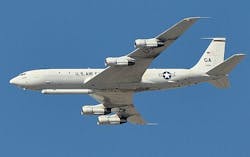Northrop Grumman orders airborne radar signal processors from Curtiss-Wright for Joint STARS
SANTA CLARITA, Calif., 11 Sept. 2013. Aircraft surveillance experts from the Northrop Grumman Corp. Aerospace Systems segment in Melbourne, Fla., needed radar processing technology for the Joint Surveillance and Target Attack Radar System (Joint STARS) aircraft. They found their solution from Curtiss-Wright Controls Defense Solutions in Santa Clarita, Calif.
Northrop Grumman has awarded an $8 million follow-on production contract to Curtiss-Wright to provide an upgraded digital signal processing (DSP) system for the Joint STARS program. The estimated value of this follow-on embedded computing order over the lifetime of the program is $22 million, Curtiss-Wright officials say.
Joint STARS is an airborne command, control, intelligence, surveillance and reconnaissance (C2ISR) aircraft for the U.S. Air Force's air-to-ground battle management and surveillance operations. The Air Force's Radar Airborne Signal Processor (RASP) system performs the radar signal processing capabilities of the Joint STARS aircraft, enabling its ability to process data to locate and track ground targets.
The contract is part of a larger upgrade to the RASP system used in Joint STARS. The radar signal processors represent one of two subsystems that Curtiss-Wright supplies on the Joint STARS aircraft. Under the contract, the award began in November, 2012. The program is expected to continue through 2015.
For more information contact Curtiss-Wright Controls Defense Solutions online at www.cwcdefense.com, or Northrop Grumman Aerospace Systems at www.northropgrumman.com/AboutUs/BusinessSectors/AerospaceSystems.

